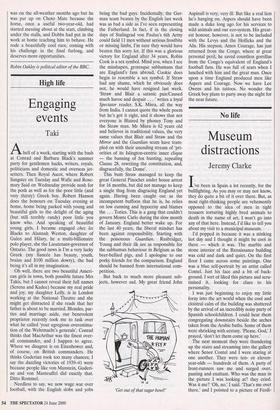No life
Museum distractions
Jeremy Clarke
I've been in Spain a lot recently, for the bullfighting. As you may or may not know, they do quite a bit of it over there. But, as most right-thinking people are vehemently opposed to the idea of men in tight trousers torturing highly bred animals to death in the name of art, I won't go into any of that here. Instead, I'd like to tell you about my visit to a municipal museum.
I'd popped in because it was a stinking hot day and I thought it might be cool in there — which it was. The marble and stone interior of the Renaissance building was cold and dark and quiet. On the first floor I came across some paintings. One was a blue self-portrait by an artist called Contel. Just his face and a bit of back- ground. I sort of liked this picture and scru- tinised it, looking for clues to his personality.
I was just beginning to enjoy my little foray into the art world when the cool and cloistral calm of the building was shattered by the arrival of an incredibly noisy party of Spanish schoolchildren. I could hear them congregating downstairs beside the arches taken from the Arabic baths. Some of them were shrieking with ecstasy. 'Please, God,' I prayed, 'don't let them come up here.'
The next moment they were thundering up the stairs and streaming into the gallery where Senor Contel and I were staring at one another. They were ten- or eleven- year-olds — hundreds of them. A party of front-runners saw me and surged over, panting and exultant. Who was the man in the picture I was looking at? they cried. Was it me? 'Oh, no,' I said. 'That's me over there,' and I pointed to a picture of Ferdi- nand VII. They looked doubtfully at the ugly monarch for a moment and then changed the subject. It was the day of the England v. Germany match and I was wearing my red England shirt. They had seen the rioting on the news. Was I a foot- ball hooligan? they wondered. 'Of course,' I said. 'We arc all football hooligans in England. It is an important part of our cul- tural heritage.' Ahr they said. Then more of these schoolchildren clus- tered round me — they were three or four deep in places by now and I was becoming frightened — and a boy with glasses put up his hand and asked me whether or not English people believed in God. 'Oh, yes,' I said. 'Lots of us believe in God. And in Jesus Christ.' And the Pope?"No, not the Pope.' Why not?' I looked around me at the upturned, expectant faces. It was a con- troversial subject and I didn't want to be a stumbling-block to these children. The aforementioned Jesus Christ, I knew, had had some very hard words indeed to say about those who are stumbling-blocks to little children. 'Well,' I said, 'it's because in England we are too far away.' Too far away!' they jeered. A very new argument, this, against the universal infallibility of the Pope. But I faced them down and one or two appeared willing to consider it. Then the children took me by the arms and led me away. I tried to resist them, but collectively they were much stronger than I was. Where they were taking me, they wouldn't say. As we passed along the gallery, everywhere I looked there were Spanish schoolchildren running amok. The noise was deafening. In one gallery I saw children hitting the paintings, many of which were on loan from the Prado, with their fists. In another I saw a man, who I took to be their teacher, hitting one of the children. He was holding the boy steady with his left hand and walloping him about the head with his right. When he saw his pupils parading a captured tourist past him, he stopped for a moment, grinned sheep- ishly at me, then resumed his assault on the boy. They finally released me in front of a painting of a man with a long flowing beard stooping to kiss the exposed nipple of a beautiful woman whose clothes were falling off. Their favourite picture, presumably. What did I think of that, then? they said, making proud and flourishing gestures in its direction. I'd had enough. I answered them by making a run for it.
I ran like the wind. Clutching my day- pack, I sprinted past paintings by Rubens, Brueghel, Murillo, Rembrandt and Velazquez; past carved stone arches taken from the Palace of Pinohermoso, built in the Almohad period; and past a marble column taken from a Visigoth cathedral. I ran past Roman vases and an Iberian sculpture of a man's head. I felt like a man fleeing through history. I didn't stop run- ning till I was back outside in the blinding furnace that was the street.



































































 Previous page
Previous page